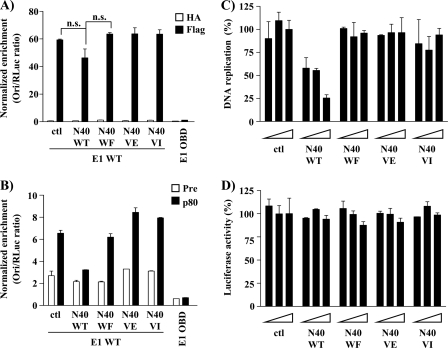Fig 7.
N40 prevents the recruitment of p80 to the origin and inhibits viral DNA replication. (A and B) C33A cells were transfected with 3F-E1, RFP-E2, and N40 (WT or mutant) expression vectors, together with an origin plasmid. ChIP assays were performed on the lysates using anti-Flag and anti-HA antibodies (A) or with a p80 antiserum or preimmune serum (B). The results of the ori enrichment levels determined by qPCR are shown after normalization to input DNA, using the internal control pRL (RLuc). Each value is the average of at least two replicates, with the standard deviations presented as error bars. An unpaired two-tailed Student's t test was used to determine if differences in enrichment levels were significant. Differences with a P value greater than 0.05 were deemed to be nonsignificant (n.s.) and are indicated. (C) DNA replication levels in cells expressing a gradient of WT or mutant N40 peptide (1, 10, and 50 ng of N40-YFP expression vector). Cells cotransfected with the empty YFP vector were used as a negative control (ctl). DNA replication activity is reported as a percentage of the signal obtained at the largest amount of YFP control vector. The error bars represent the standard deviations of duplicate values. The results are representative of at least three independent experiments. (D) Effect of N40-YFP on expression of cytomegalovirus (CMV)-FLuc in the absence of the viral proteins. The luciferase signal is reported as a percentage of the signal obtained with the largest amount of empty YFP control vector. The error bars represent the standard deviations of duplicate values. The results are representative of at least three independent experiments.

